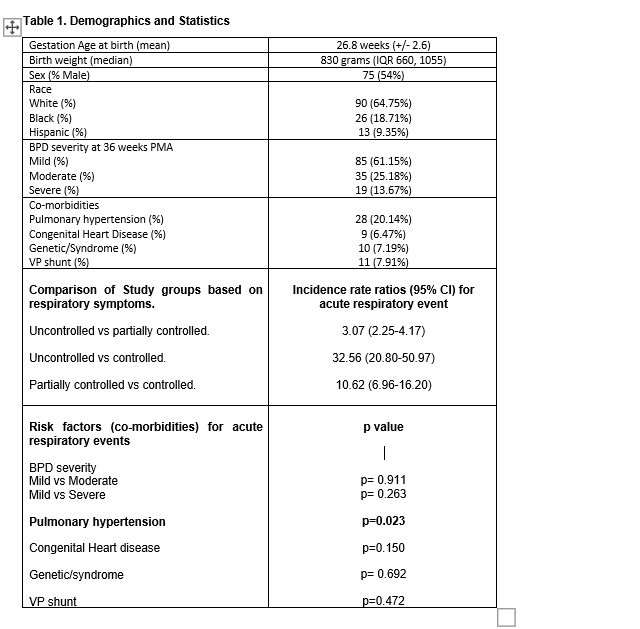Neonatology
Session: Neonatology Pulmonology Clinical Science 1: Bronchopulmonary Dysplasia
580 - Health Care Utilization among Infants with BPD during the COVID-19 Pandemic
Saturday, May 4, 2024
3:30 PM - 6:00 PM ET
Poster Number: 580
Publication Number: 580.1206
Publication Number: 580.1206
- PT
Priya Tiwari, M.D (she/her/hers)
Neonatal Fellow
Neonatology
Overland Park, Kansas, United States
Presenting Author(s)
Background: Infants with bronchopulmonary dysplasia (BPD) have long-term pulmonary sequelae. These infants continue to require high level of care after discharge from the neonatal intensive care unit (NICU). Limited data exist on the health care utilization of infants with BPD discharged from the NICU during the Covid-19 pandemic.
Objective: To determine the health care utilization of infants with BPD after NICU discharge during the Covid-19 pandemic. Secondly, to identify risk factors associated with increased health care use.
Design/Methods: Retrospective study (2019-2021) of infants with BPD (n=139) followed in multidisciplinary high-risk clinic. Demographics, respiratory support and co-morbidities were collected during the first, 6-month and 12-month follow-up visits. At each visit, subjects were assessed to have their respiratory symptoms under control (SUM score 0), partially controlled (1) or uncontrolled (2). Health care utilization is defined as acute respiratory events leading to one or more of the following: hospitalization, ED visit, sick clinic visit, use of antibiotics or use of systemic corticosteroids. A score of 1 is assigned for each event for a maximum respiratory event score of 5. Poisson regression model was used to determine the association between the SUM score and acute respiratory events. Repeated measure of logistic regression model was used to determine variables that are associated with increased health care utilization.
Results: Table 1 summarized the demographic and clinical characteristics of the cohort. During the pandemic, subjects with uncontrolled symptoms had 3 times the rate (95% CI 2.3 – 4.2) of having respiratory event compared to those who were partially controlled, and 32 times (95% CI 20.80 - 50.97) the rate of those under control. Acute respiratory events as measures of health care utilization were similar for all infants with BPD regardless of the severity of the disease (mild vs moderate, or mild vs severe, p=0.911 and p=0.263). Subjects with BPD-associated pulmonary hypertension had 3 times odds of higher health care utilization compared to those without pulmonary hypertension, p=0.023, OR 3.05, 95% CI (1.17-7.96).
Conclusion(s): During COVID-19 pandemic, infants with BPD whose respiratory symptoms are uncontrolled were more likely to have acute respiratory events that require health care use. Infants with BPD had increased health care utilization regardless of disease severity. BPD-associated pulmonary hypertension is an additional risk factor associated with increased health care utilization.

